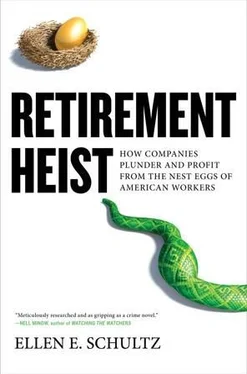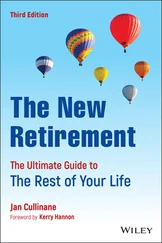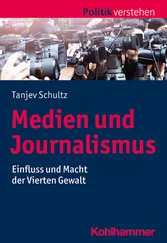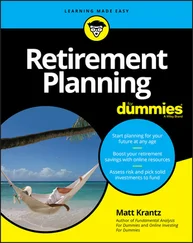Lincoln National Corp. also froze both its regular and executive pensions in 2008. When it did, it converted the executive pensions to lump sums, enhanced their value by $6.3 million, and added the benefits to a new deferred-compensation plan, to which the company will contribute a minimum of 15 percent of the executives’ total compensation each year. That year, it contributed $12.3 million to the new account for CEO Dennis Glass. The company didn’t enhance the 401(k) plans of regular employees whose pensions it froze.
One thing people can count on: Unlike the pensions of regular employees, executive liabilities aren’t going away. They’re protected by contracts. Though lower-level executives can lose their deferred comp in bankruptcy, the pensions and savings of top officers are usually protected by bankruptcy-proof trusts. Chesapeake Energy, the secondlargest natural gas producer in the United States, doesn’t disclose the total amount it owes executives, but it’s no doubt a hefty sum. Aubrey K. McClendon, the chief executive, had compensation that totaled $156 million in the last three years. He’s also owed $120 million in pension and deferred-compensation benefits. In its annual report, Chesapeake needs thirty-four pages to describe its executives’ retirement benefits. The benefits for 8,200 employees require only half a page to describe—they don’t have pensions.
Pensions aren’t the only executive liability. So is much of their pay. Unlike salary paid out to factory workers or the CFO, deferred compensation creates huge, and largely hidden, obligations. The plans can cover thousands of lower-level executives and other highly compensated employees, who participate in so-called excess plans. These enable employees to defer some of their salary that they can’t put into the 401(k) because of tax laws that limit total employee contributions to $15,000. So if a 401(k) allows employees to contribute 15 percent of pay, someone making $200,000 will be allowed to contribute only a total of $15,000 to the 401(k), and can defer the rest in the excess plan.
These are also called mirror plans, because they “mirror” the 401(k). The only difference is that the amount deferred into the excess plan isn’t actual cash, as it is with a 401(k), but an IOU from the company for the pay. Nonetheless, the employee allocates it among virtual mutual funds—usually the ones available in the 401(k)—and may also receive virtual employer contributions.
Upper-level executives often have more elite deferred-compensation plans that enable them to defer upward of 100 percent of their salary and bonuses each year, and sometimes restricted stock or the gains from exercising stock options.
The deferred pay can grow quickly. Companies might contribute a percentage of what the executive defers or make an outright contribution, no strings attached. The savings grow with returns pegged to investment, or with guaranteed returns—as high as 14 percent at GE. The accounts also grow with company contributions, such as the 20 percent match that drug giant Wyeth provides its top executives. John Stafford, the former chairman, one year collected $3.8 million in interest alone on his deferred-compensation account, valued at nearly $38 million. Together, the value of the company contributions and tax-deferred returns can boost the value of the pay by 40 percent.
Companies are required to report only guaranteed above-market interest paid annually into the accounts of the five highest-paid executives, and include the size of each individual’s accounts in a separate table. But the total amount of all the deferred compensation of hundreds of executives is typically hidden.
Totting up the total amount a company owes its executives can take some creativity. One way to get a sense of their size is to look at a reporting item called a “deferred tax asset.” Companies can deduct compensation they pay, but only when they actually fork over the money (or put money into the pension or 401(k) plan).
When compensation is deferred, companies record a deferred tax asset for the compensation, which is essentially an estimate of how much the company will be able to deduct in the future—when it actually pays executives what it owes them. JPMorgan Chase, for instance, reported a $3.4 billion deferred tax asset for employee benefits in 2007. Assuming a 40 percent combined federal and state tax rate—and backing out obligations for retiree health and other items—this indicates that the financial giant owed its executives $8.2 billion just before the market crisis. Applying the same technique to Citigroup yields roughly a $5 billion IOU, primarily for restricted stock shares of executives and eligible employees. Fannie Mae had a liability of roughly $500 million for executive pensions and deferred compensation at the end of 2007, judging by the size of its deferred tax assets. The liability remained even as the troubled company was placed into conservatorship.
By many means, including the relentless cuts to pensions and retiree health benefits, executive pay tied to stock performance and earnings continues to climb. But how much are executives really taking home? For all the hand-wringing by compensation critics, the magnitude of executive pay has remained an elusive figure. But given that so much of it creates an ongoing liability for both the supplemental pensions and deferred compensation, knowing how large the total is can help investors, at least, gauge the pension headwinds ahead.
An indirect way to calculate the percentage of pay executives collectively receive at U.S. companies is to look at payroll tax data compiled by the Social Security Administration, which most people know as FICA. The key: Only earnings up to a certain ceiling are subject to a U.S. payroll tax of 12.4 percent, split between employer and employee, which finances Social Security retirement benefits. The ceiling, which is indexed to the average growth in wages, was $106,800 in 2010. (Employers and employees also each pay 1.45 percent on an individual’s total income, with no salary ceiling, to fund Medicare.)
The Social Security data shows that 6 percent of wage earners have pay that exceeds the taxable earnings base, and that their “covered earnings” above the taxable maximum totaled $1.1 trillion in 2007. Adding the portion of their pay below the taxable wage base, $991 billion, produces a total of $2.1 trillion. In other words, by 2008, executives were receiving more than one-third of all pay at U.S. companies—more than $2.1 trillion of the $6.4 trillion total compensation.
The 6 percent of those taking home one-third of all pay includes everyone earning more than the wage base. But the top 2 percent of earners account for the lion’s share of the $2.1 trillion. And that’s just the pay top earners receive or defer. The figure understates executive pay because it includes just salary and vested deferred compensation, including bonuses.
It doesn’t include unvested employer contributions and unvested interest credited to deferred-compensation accounts. Nor does it include unexercised stock options (options aren’t subject to payroll tax until exercised) and unvested restricted stock (which isn’t subject to payroll tax until vested; the subsequent appreciation is taxed as a capital gain). [11] An executive’s ability to delay paying payroll taxes on compensation is in itself an economic benefit that ultimately boosts executive paychecks. And at some companies, they don’t pay payroll taxes at all: The companies reimburse them for their FICA payments.
Also not included in the total compensation figures are types of executive pay that are never subject to payroll tax at all. This category includes incentive stock options (which are generally taxed as capital gains) and compensation characterized as a benefit (certain benefits, including pensions, aren’t subject to any Social Security taxes). The compensation data also leave out compensation paid to hedge fund and private equity managers. The billions they receive isn’t considered pay; it’s treated as “carried interest,” which is taxed as a capital gain.
Читать дальше












